Road to Hana 2013
Part
Two
Written by Rick Archer
February 2014
The Day Begins
It is now Tuesday, October 1, 2013. Yesterday we
visited Waikoloa Village on the Big Island.
Today our
ship has arrived in Lahaina.
This is our Big Day: The Road to Hana Revisited.
Both Marla and I were bitterly disappointed to cut our trip
short on our previous trip to the island in 2007.
Now we have a second chance. We have big plans to see the Seven Sacred Pools,
the big attraction in Kipahulu at the end of the Road to
Hana. We have our bathing suits ready; we're going
swimming!!
The bad news is that our 2013 ship was docked in Lahaina,
not in Kahului like it was back in 2007. This added 14
miles to our trip in both directions. I estimated this
add an hour to our day.
Another delay is the need to take a "tender" to shore.
Since our ship was docked well out in the water,
Marla and I were forced to wait in line to get on a "tender",
a mobile boat that ferries passengers to and from the ship.
Just as we got off the tender, we were dismayed to see the
car rental shuttle
bus driving off. We had walked to our car rental place
yesterday, but that was not an option today. Since the
rental office was five
miles away, we had no choice
but to wait.
For lack of anything better to do, Marla and I sat down.
Now we waited. And we waited. And we waited some
more.
30 minutes passed. Patience is a necessary skill to
develop when you travel because there will always be
inevitable delays. Thanks to Marla's experience, she
finds ways to sidestep some of the delays, but we do our
fair share of waiting as well.
As we waited, more passengers from
the ship got off the tenders and joined us. Now Marla was worried there was a
chance we wouldn't get a seat on the next shuttle because
there seemed to be more
people waiting than the shuttle bus could hold.
This crowded situation led to a very strange development.
|

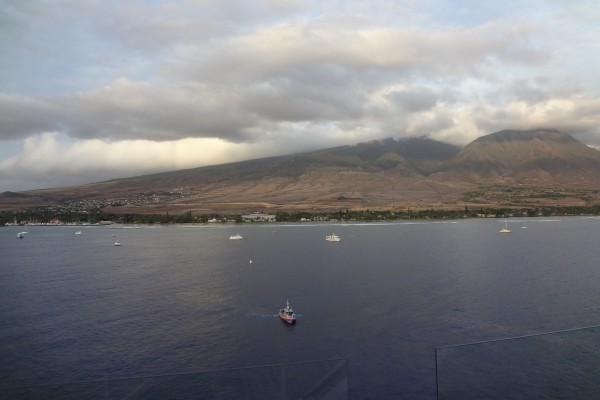
Many
modern cruise ships have become so enormous that they simply
cannot dock close to shore in the waters of certain ports.
So the ship has to 'tender' its passengers to shore. This
picture shows a tender ship coming to pick us up and take us into Lahaina. Sorry
to say, but Tendering is a pain in the butt and a big
waste of time.
Note
the clouds over the West Maui volcano and the brown slopes.
Since Lahaina is on the
"leeward side", it doesn't get much rain.
|
The
Hawaiian Golf Course Lifestyle
|
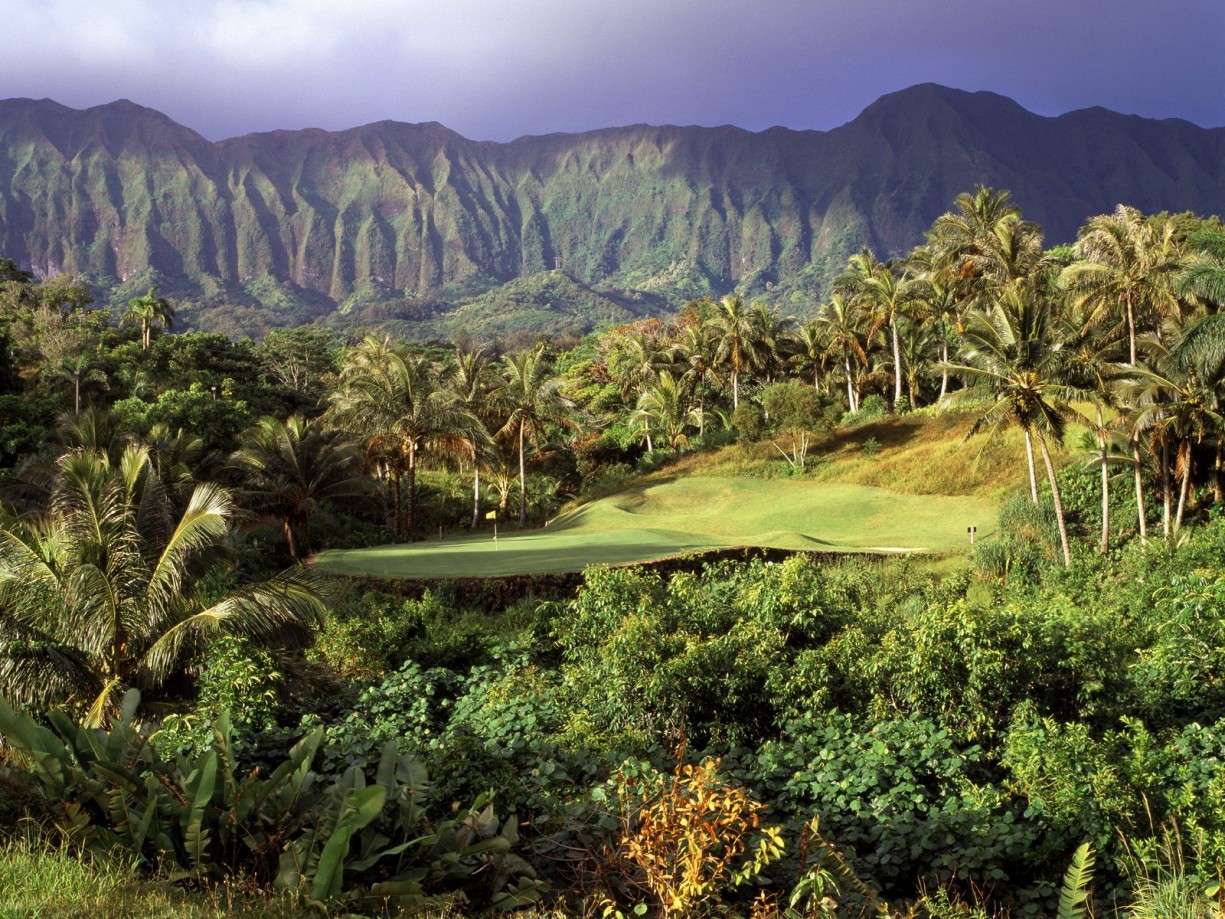
Rick's
Note: Apparently there are two kinds of golf courses
in Hawaii. Some courses like the one above are carved right
out of the lush jungle.
Other
golf courses like this one at Waikoloa are reclaimed from
vast barren lava fields by putting sod atop the lava, then
growing grass by means of extensive irrigation. The
next step is to build huge resorts, malls and luxury estates
along the perimeter of the golf courses. I wrote
a story about this golf phenomenon in a previous article
Waikoloa Village.
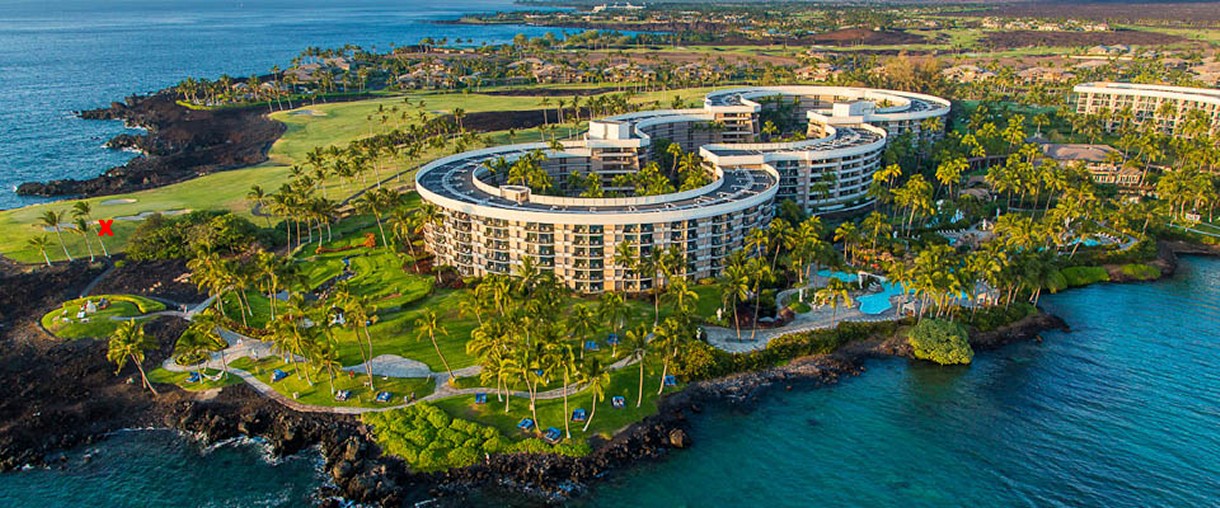
|
Maui
Golf Courses
Did you know that they take golf very seriously in Hawaii??
Golf is to Hawaii as gambling is to Vegas. Golf is the
lure that brings the big spenders to its shores. In
case this is news to you, here is a typical Internet blurb.
Welcome to Golf Paradise! Blessed
with breathtaking scenery, unforgettable
signature holes and championship caliber course
design, it's no wonder Hawaii attracts so
many golfers from around the world.
Hawaii is famous for is its collection of
world-class golf courses. If your
conception of Hawaii is just about the beaches,
cliffs, and volcanoes, then it's time you
include golf with the idea of Hawaii.
Challenges abound from greens lined with
volcanic rough to stunning seaside water
hazards.
As
a scenic destination, only a few places in the
world can be compared to the beauty of Hawaii's
coastline and beaches. Where else can you
find a golf course with jungle, ocean, lava and
looming volcanoes?
With more than 70 amazing golf courses to
choose from, it won't be difficult to find the
perfect course for you. This will be your
golf
experience of a lifetime.
Make Hawaii your next Golf Destination.
|
Rudeness in Boston
People take their golf in Hawaii seriously.
Unfortunately, some people take it a little too seriously.
Our 2013 visit to Maui set the scene for one of the most incredible incidents
of rudeness I have ever witnessed in all my travels.
Previously the most memorable incident of rudeness took
place in a Boston hotel during our 2006 New England cruise.
There were four of us in the lobby. Marla's brother Larry
had just begun checking in for his room while Marla and I
stood nearby chatting with Larry's wife Roz. The lobby
was fairly deserted. There was no long line. In
fact, Larry was the only guest in line and there was only
one clerk on
duty.
The clerk was busy clicking away at the computer keyboard to
confirm Larry's reservation. In other words, the
'process' was already in progress.
Out of nowhere, a well-dressed, white-haired older man
walked up and cut in front of Larry.
To do so, he had to actually insert himself between Larry
and the counter.
As he jostled Larry out of position, the man smiled at Larry, then uttered
these words, "I'm sorry, but I am important and I am in a hurry."
That's all the guy said. He didn't bother to check to
see if this was okay with Larry or not. Instead, the
guy turned his back and started
ordering the hotel clerk around.
Marla, Roz and I saw the whole thing. To our astonishment, the
hotel clerk stopped Larry's confirmation process and began to wait on the Important Man instead.
Larry stood there dumbfounded. He was so surprised
he didn't know what to say. That made two of us!
I had never seen anything like this before. Like Larry, I
just stood there in open-mouthed shock. The nerve of
that guy to push Larry aside!!
I was ready to
say something to the Important Man about "manners", but the two women
pulled me back. Don't make a scene! So I just stood there and seethed.
Of all the nerve!
Rudeness in
Maui
Among the people that had joined us to wait for the Maui
shuttle were two separate "foursomes". Based
on their dress and demeanor, the eight people seemed
wealthy. Each person seemed slightly older than me, maybe late
sixties. I kick myself for not taking pictures; it would have made my story easier to tell.
Just take my word for it they had "The Well-Healed Look".
Since there was absolutely nothing else to do, I observed
both groups in action. The first foursome was completely
aloof. They stayed to
themselves and carefully guarded their four bags of golf
clubs.
Golf clubs? I frowned. This foursome seemed to
be from the ship. Who on earth takes their golf clubs
with them on a cruise trip? Wouldn't it be easier to
simply rent clubs at the course?
Of course I have to admit I don't 'understand' golf.
I'm sure there must be a perfectly valid reason to haul
those clubs around.
The second foursome was very nice. They did not have
golf clubs. The two ladies
sat near me and I made friends with
them. Like us, they were waiting for the shuttle.
Tired of waiting, one of their
husbands had a very good idea. He pulled over a cab.
Without fanfare or warning, just like that the four of them got in. In return for
the $30 cab fare, they were able to
beat the huge crowd to the car rental joint. Gee,
wouldn't it be nice to be rich?
As I pondered the value of this clever move, some pretty girls in a
wedding party crossed our path on the way to a
limousine. I waved at them and got some great smiles
in return. It is so much fun to flirt with pretty
girls... in an innocent way of course.
Then I noticed someone was frowning at me. Ah, Marla.
No, she wasn't jealous. She was mad because I wasn't
paying attention (a common theme on trips; I get distracted
easily).
Marla was irritated with me because the bus had just
appeared in the distance and I was fooling around taking
pictures. She had a point. I was so preoccupied,
I didn't realize the bus was here. Actually no one
else did either.
Only Marla knew.
There are advantages and disadvantages to having a brilliant
wife. The main disadvantage is that Marla is "right"
about things much more often than me.
This is terrible for
my self-esteem. Whatever happened to the rule that
girls are supposed to play dumb so boys like me can
feel better about themselves? Instead I am frequently left
feeling inadequate. It hurts a lot. People call me "Mr.
Marla".
It doesn't help that Marla says she married me for three
reasons in particular. One reason is to step on bugs
at home and get rid of them. Another reason is that
she needed someone to carry her heavy luggage on trips.
I don't mind this role, but I do wish she wouldn't
refer to me behind my back as "The Big Lug".
On the other hand, there are advantages to having a smart
wife. Marla definitely catches onto things faster than the
average citizen.
Marla already knew what the shuttle looked like because earlier she had
taken note of the first bus in the distance as it pulled away. Consequently Marla spotted the shuttle's
return
long before anyone else had any idea.
Now Marla asked me to move into position before the rest caught
on. So I hustled over to the likely pickup spot. Here
is where I come in handy. Marla may be smarter than
the average citizen, but I am bigger than the average
citizen.
Once I was first in line, no one was going to
dislodge me. That's the other reason she married me.
Thanks to my massive frame,
Marla was the first person on the bus. And of course I
sat next to her.
The two of us were all set in the most convenient seat.
However, people were having trouble climbing past me to sit in the back.
To make things easier, I got out of my seat and went back
outside. Marla
and my back pack guarded my spot.
Soon the bus was nearly full. I watched as one of the
two men in the "aloof foursome" raced to open the front door and plunge himself
into the solo seat beside the driver.
That's when I
noticed his three companions were still outside the bus
and looking very worried. I also noticed that the bus
was nearly full. I looked again and realized there was
only one seat left for these three people.
The wife of the man in the front seat was right next to me.
She had a perplexed look on her face. I offered to
let her sit in the final spot next to Marla.
There was room on our seat for three people, so now Marla scooted
from the middle over to
the window to make room for the golf lady. My back
pack occupied the one
remaining spot on the edge of the seat for me.
The golf wife, a slender woman, was stuck carrying two golf bags... his bag and her
bag.
The woman could barely lift the golf clubs, so I came to her
rescue. I told
her to be seated next to Marla and I would take care of the golf bags.
I put one bag
on the floor in front of Marla. There wasn't room on
the floor for the other bag.
The husband had remained seated the
whole time as I handled his golf clubs for him. From
there, he turned around and watched everything like a hawk.
Noticing my back pack, he barked at me to move the back pack
and put the second set of
golf clubs in the place where I would be sitting.
I
don't know if he realized that was my seat or not. It
seems difficult to believe he was that oblivious.
I
was incredulous. I
had not expected that. Did this man really expect me
to give up my own seat for his golf clubs? Now Marla
stared darts at me as
if she thought I was lackey enough to follow this blowhard's
absurd demand.
I
told the man politely that was my seat and he needed to find room for his
clubs up front. Without bothering to apologize, he said there was no room up front.
I frowned and prepared to get into it with him.
Fortunately a confrontation was avoided when a
man in back volunteered there was room on the floor in back.
So I handed the second bag of clubs over people's heads till the bag
reached the back. Now this particular issue was solved.
However, we weren't done yet.
As I climbed in to take my seat, the second couple lingered
outside the shuttle bus. I assumed they were out of
luck; they were the only people who had not gotten a seat.
Now I saw the wealthy man up front conferring with the bus driver.
Never in my wildest dreams could I have imagined what came
next.
The bus driver made an announcement. He
said the four people with the golf clubs had an early
pre-paid appointment at an extremely exclusive golf course here on Maui.
If they missed their "tee time", they would likely never
get another chance.
Would two people please get off the bus to make room?
That explanation didn't make much sense to me. You can
always squeeze someone with an existing reservation into a
round of golf (just let someone else start early)... but I
let it pass.
Instead I focused on the reaction to the bus driver's
request. I looked at Marla and Marla looked at me. Out
of respect for the golf wife next to us, we didn't say a
word, but we both thought the same thing. Are these people
out of their minds?
If
this tee time was so damn important, why didn't they hail a
cab like the other two couples? Too cheap or too
stupid?
The nerve of these people to think their lives were more
important than these other people on the bus.
Well, no one budged. So the bus driver shrugged his
shoulders to Mr. Golf Club and APOLOGIZED. Now Mr.
Golf Club opened the
window and told the second couple to just wait here.
He
would drive back with the rental car and pick them up.
And with
that, the shuttle took off. I
was curious about Mrs. Golf Club sitting next to me. I still had a
hard time believing her husband had been so worried about
getting that seat that he had left her standing outside holding both golf
bags.
So I struck up a conversation. Mind you, no harsh
words had been said; she didn't realize the contempt I felt
for her husband. I quickly learned a fascinating fact:
both couples lived in Honolulu on nearby Oahu just 90 miles
across the water.
This meant they had flown to San Diego in order to cruise
back to their own islands. This seemed more than
slightly out of the way, so I wanted to know more. But
I needed to disguise my true colors. So I used an old
trick - I complimented the quality of the golf clubs in the
bag at our feet.
Oh my goodness, that worked wonders. The story gushed
out.
Both men were avid golfers. However, since it was expensive to travel from island to island even
for a Hawaiian resident, it was more convenient to
hire a cruise ship as their personal ferry.
The men even had a way to write off this cruise as a
business expense. I
asked how that worked. She said her husband was
claiming the other man as a consultant. And the other
man was claiming her husband as his consultant.
Apparently they had worked this scam many times over the
years without problem.
Mind you, the word 'scam' is my word, not hers. She
talked so matter of fact that I had to assume she not only
approved, she couldn't imagine why there was anything wrong
with it.
Meanwhile I was strangely amused to discover it was cheaper for these golf fanatics to simply fly
to San Diego, play the excellent golf courses there, then get on this
ship and be ferried from island to island to play
more famous golf courses.
I
quietly asked another innocent question. How many golf
courses had they played so far on this trip? She said
five: two in San Diego, one in Hilo, two in Kona.
They would be playing two more famous courses today - Kapulua
in the morning and and Wailea on the other side of
the island in afternoon. Plus they had an important
dinner reservation in Lahaina that evening.
Aha. Now I had my answer. They weren't worried
about losing their morning reservation; they were worried
they wouldn't have enough time to make their afternoon
reservation and still have enough time left for their dinner
reservation.
So little time, so much to do.
And that was my peek into the golf lifestyle of the rich and
famous. I
concluded some people see life completely different than the rest of us.
|
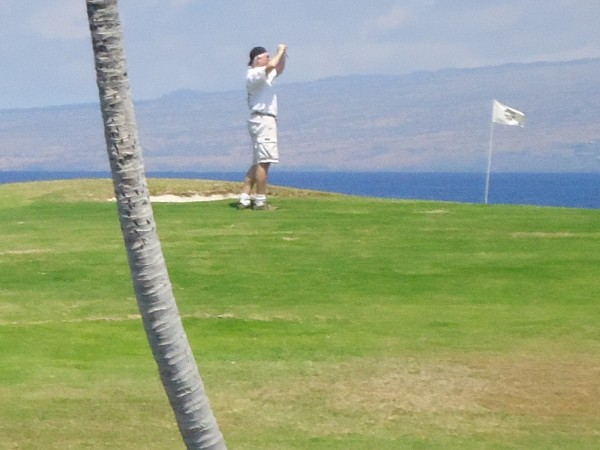
Thanks
to my visit to
Waikoloa Village
on the Big Island one day before my Road to Hana adventure,
I was able to get a first hand look at this golf course reclaimed
from a Mauna Kea lava range.
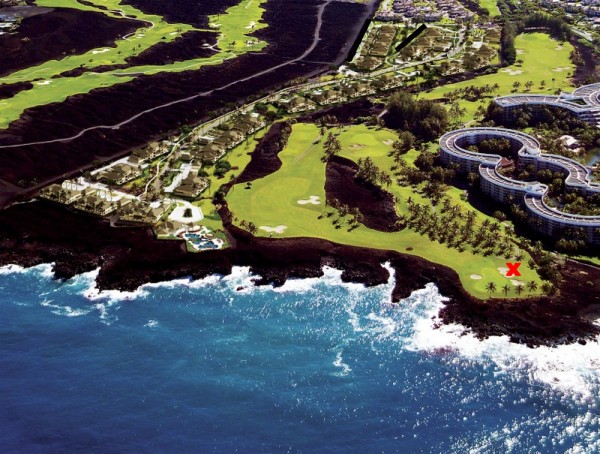
This
an aerial photo of the same Waikoloa golf course where I
took my picture above. The red X shows where I was
standing.
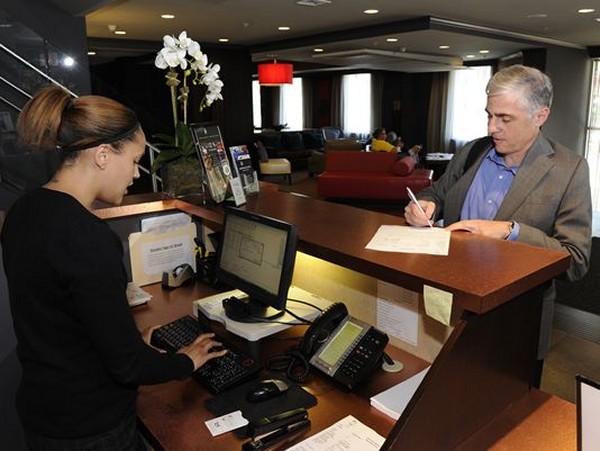
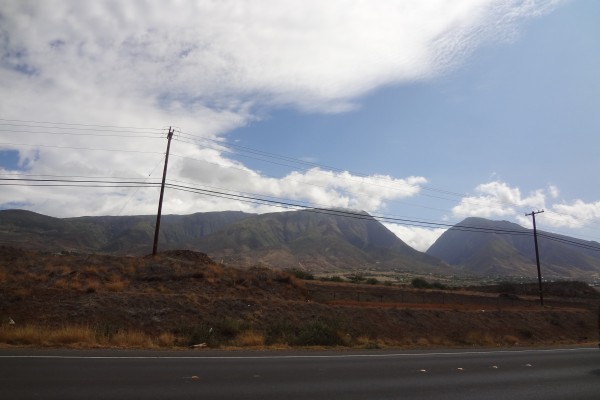
Just
as
Mount Haleakala blocks rainwater from reaching the south
side of East Maui, these West Maui volcanic mountains
prevent the
clouds and the moisture from reaching Lahaina on West Maui. This accounts for the barren landscape in
the picture.
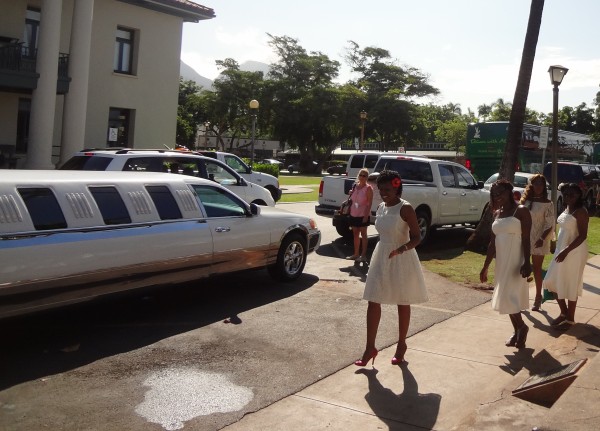
Here
you can see Marla has her head cocked in disgust while I
waste precious time taking pictures of these young
ladies.

The Lady
and the Lug. I
suppose I have
had better hair days.
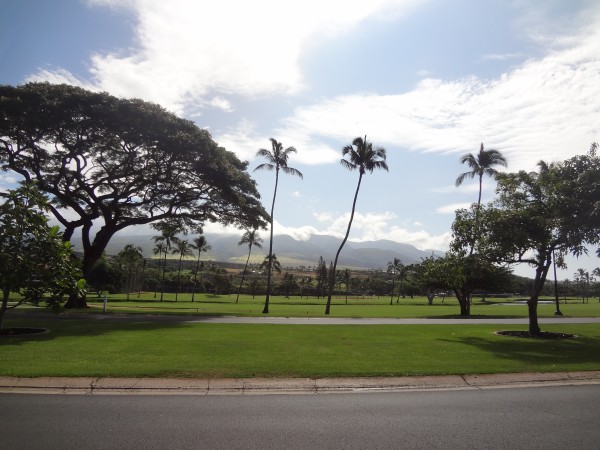
Maui is said to be home to some of the finest golf courses
on the planet. Unfortunately, since Lahaina doesn't
get much rain, like Waikoloa it is forced to use artificial
means to create its golf courses. This picture shows is a lovely green golf course in front of
the Westin Maui hotel where we picked up our rental car.
As one can gather, it owes its existence to the liberal use
of water sprinklers.
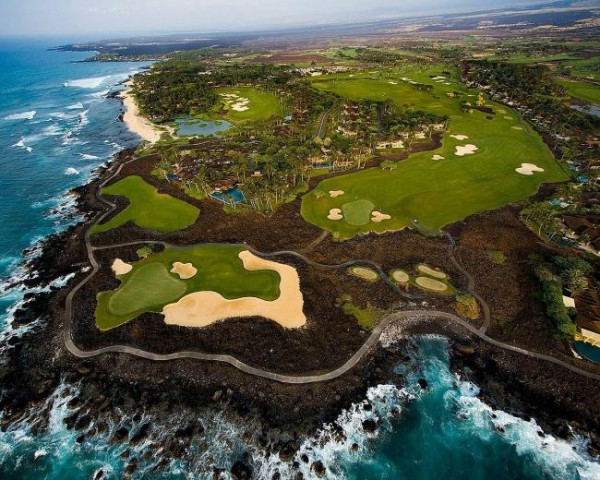
Another Maui golf course carved out of lava. Whatever
your feelings about golf, you have admit this scenery is
amazing.
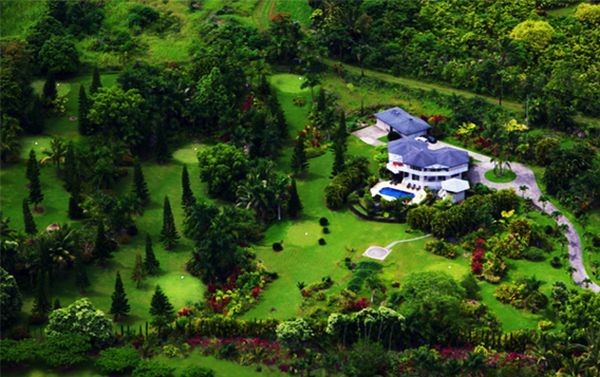
This
Maui golf course was carved out of the jungle near Hana
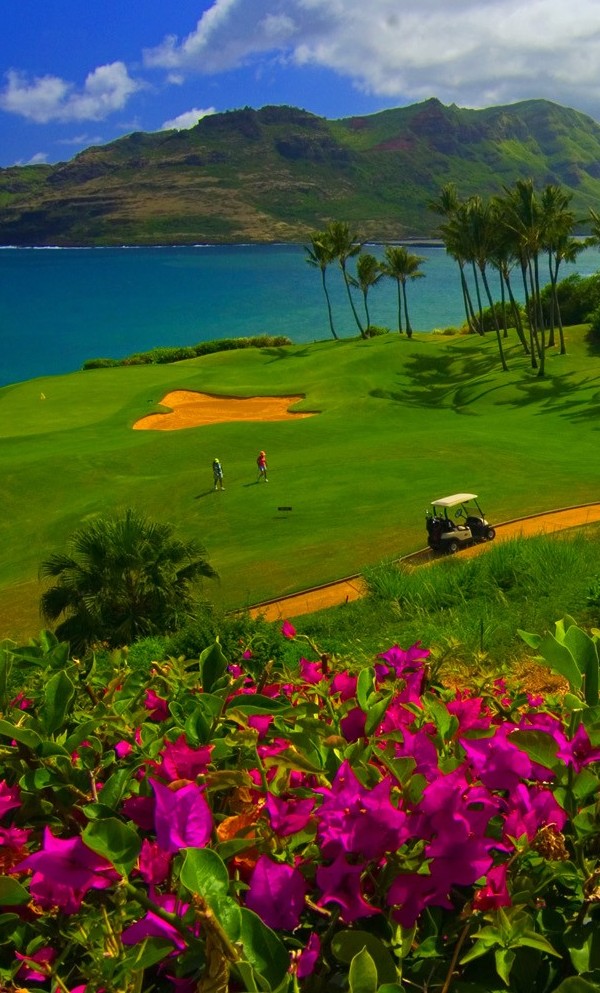 |
| |
 |
History of the
Road to Hana
|
From our start point in Kaanapali next to Lahaina,
Hana was said to be 81 miles away. Our first
destination was to Kahului, a midway point some 20
miles from Kaanapali. Since it was all highway, we
made fairly good time. It took us 30 minutes.
Kahului is the northern point of a large valley
situated at the footsteps between Haleakala and the West
Maui volcano. Kahului is important mainly because it is
centrally located at the
crossroads of everything on the island. Not only does
the city feature a deep port and an airport, it serves as the
gateway to the Road to Hana.
When Marla and I visited Maui back in 2007, our ship was
docked in Kahului. The advantage was that our
starting point was much closer to Mount Haleakala and the
Road to Hana.
Kahului was our friend six years ago, but not today.
This time we found Kahului to be a major pain in the
neck. I swear the main drag seemed to have a stop
light and a mall on every block. The traffic was
terrible. It took 20 minutes or so just to get through
one mile of this bottleneck.
|
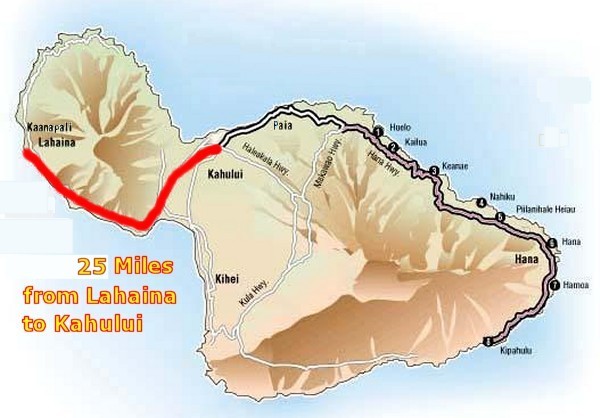 |
Fortunately, once we left the town, we hit open roads again.
That is when
I saw several sugar cane fields. Apparently the
Road to Hana owes much of its existence to the once
vitally important sugar cane industry on the island.
Before the English even came to Jamestown, Virginia, in 1607,
the Road to Hana existed as a footpath through the jungle
and
along the beach. The ancient Hawaiian natives certainly had no need for
large roads.
When the rains made the footpath unusable, they could just
as easily use their ocean canoes to get wherever they wanted to go.
The Hana coast is rich in Hawaiian history. It has been the scene of
many turning points in Hawaiian culture. It was the
15th-century King Piilani who first united the island
of Maui.
Unlike previous kings, Piilani was a builder. He was more interested
in development than further conquest. He built
fishponds, irrigation fields, paved roads, and the massive Piilanihale Heiau temple, which still stands today in Kahanu
Garden. It was Piilani's sons and grandson who built
the first Road to Hana. It stretched from west Maui, along the
coast, and up the Kaupo Gap and through the Haleakala
Crater.
In memory of his deeds, today's Highway 31 on the backside
of Haleakala is known as the "Piilani Highway".
For centuries, thanks in large part to Haleakala's massive daily ration of
rainwater, Hana has been a prime location for farming.
In 1849, a cantankerous sea captain named George Wilfong brought
commerce to this isolated village by starting the first
sugar plantation on 60 acres. Because his harsh
personality and unreasonable demands for plantation work did
not sit well with the Hawaiians, they rebelled. Wilfong
bypassed the locals and brought in Chinese
immigrants, the closest thing to slave labor.
Shortly after that King Kalakaua
entered into an agreement to import sugar into the United
States duty-free.
In 1864, August and Oscar Unna, two Danish brothers, contributed to the growth of the local sugar industry
by establishing the Hana Plantation. Four years later they
brought in Japanese immigrants to labor in the fields.
By 1883, due in large part to demand created by King Kalakaua’s treaty, the number of sugar
plantations in Hana had grown to six large estates.
At the turn of the 20th century, sugar wasn't the only crop
booming in the Hana area. By 1900, rubber was being
commercially grown in Nahiku, wheat in Kaupo, pineapple in
Kipahulu, and tobacco in Ulupalakua.
At this time there were small roads going from one
plantation to another as well as partial routes from
Paia to Hana.
Like Kahului, Paia was situated on the north shore of the
isthmus in the foothills of Haleakala. Paia had wide
open fields perfect for farmland, but it was also located
right on the doorstep of the tropical jungle created by
Haleakala. Therefore the Road to Hana uses both
Hana and Paia as its bookends.
Paia became Hana's "land line" to the rest of Maui. As
the sugar cane industry expanded in the late 1880s, goods
were frequently transported through narrow paths carved in
the jungle along the coast. The problem was a lack of
reliable roads to bring workers to and from Hana or to carry
goods out from the town’s thriving plantations. Any
good rain storm could destroy these footpaths.
The solution came in the early 1900s. A prison was
built in the town Keanae located halfway between Paia
and Hana. Keanae was chosen as the site of the prison because
prisoners and supplies could be brought there by using a
large dock.
At this time pickax-wielding convicts carving a very narrow
coastal highway out of the lava rock and jungle. At
the same time a total of 59 bridges had to be built over the
countless ravines and fissures created by the constant
rainfall. Locals from Keanae and Hana were hired to maintain
the road as it was being built. This primitive road
was finally opened in 1926.
The opening of the road in 1926 brought with it a surprise.
Now for the first time the outside world was able to
discover the tiny little village of Hana. However, it
took considerable effort. The mud and gravel road was
extremely tough on any vehicle.
Furthermore the road was very undependable. Thanks to
the constant daily attack of rainfall, the road was often
vulnerable to
landslides and washouts.
However, despite the
headaches with the road, the Hana community was largely prosperous during
the first half of the Twentieth Century.
The Darkness
of the Forties
Then came the Forties. Now all hell broke loose as 3
major disasters hit the area.
The first disaster we all know about, something called
"Pearl Harbor" and "the day which will live in infamy".
Although Maui itself was not damaged, things would never be
the same on the islands in general.
The second disaster was much different. On April Fools Day
in 1946, an earthquake off the coast of the Aleutian Islands
in Alaska spawned a series of gigantic tsunami waves. One
wave as high as a 13-story building hit the northeast coast
of Maui.
The damage along the Hana coast was catastrophic: The Keanae
Peninsula was swept clear (only the stone church remained),
the town of Hamoa was totally wiped out, and several entire villages
completely disappeared.
There were no early warning systems in place in those days.
The massive waves came as a total surprise.
Only heroic efforts such as this story kept the death toll from
being worse:
"Mr.
Hilario Aquino said that when the waves hit the church,
he was tossed out amidst the children. He swam about
rescuing the children and lifting them up into the large
trees of the church yard. When the waves subsided,
10 of the children were found safely clinging to the trees.
Their parents all agreed that Mr. Aquino had saved their
lives."
-- From the Honolulu Star Bulletin, April 05, 1946
The third disaster may have been the worst of all. The
sugar cane industry went into decline after World War II.
Apparently the Maui locals who had served in the Pacific
Theater during the war were no longer willing to work the
sugar cane plantations for the kind of wages that were being
offered. The labor unrest that followed was the death
knell for this struggling industry.
Charles Brewer, owner of the largest sugar plantation in
Hana, decided to shut down his operation instead of fighting
the labor union. The closure of the plantation meant not
only the loss of thousands of jobs, but also the loss of
plantation-supplied homes and the entire plantation
way of life. The loss of the agriculture industry was
crippling.
The Fifties continued to be a time of trouble for the island as many of
the population left to find employment elsewhere. For a
while there, the Hana area became a ghost town of sorts.
Resurrection
Hana regained its happiness thanks to two bright spots.
I assume most of you have heard of legendary baseball star
Joe DiMaggio, husband of some lady named Marilyn Monroe.
Back when DiMaggio was starting his baseball career, he
played for the San Francisco Seals, a highly popular minor
league team.
The Seals baseball team was owned by Paul Fagan, a
man who fell absolutely in love with the Hana area.
Paul Fagan
was an entrepreneur from San Francisco who had
bought the Hana Sugar Company. He would
go on to become the town's
savior.
Fagan wanted to retire in Hana, so
he focused his business acumen on this tiny town with
its big
problems. Recognizing that
sugar was no longer economically feasible, he looked at the
community and saw other opportunities. He bought 14,000
acres of land in Hana, stripped the
sugar cane away, planted
grass, and shipped in 300 Hereford
cattle from his ranch on Molokai.
Overnight the cattle industry replaced the sugar cane
industry.
Years ahead of his
time, Fagan had another idea too. Fagan thought
'tourism' might have a future in Hana.
So he built a small six-room inn
and named Kauiki Inn.
This later
became the Hotel Hana-Maui, today a
popular spot to visit in Hana.
When
Fagan opened
the hotel in 1946, he said
it was for first-class, wealthy travelers,
the sort of people who were his
friends. Not only did his friends come, but he also pulled off
a public-relations coup that is still talked about today.
In 1947, Fagan's baseball team, the San Francisco Seals,
needed a spot for spring-training area.
Why not use Hana?
So Fagan brought
out the entire team to train in Hana. More
important, he
brought the Frisco sportswriters along with him.
The sportswriters
were blown away by the beauty. They
penned glowing
reports about the town.
"The place beggars description," wrote Harry Borba in the
old San Francisco Examiner in February 1947. "The Seals
ballplayers should pay for the privilege of training in such
indescribably beautiful surroundings."
One writer gave the town a name that
stuck: "Heavenly Hana".
Another stroke of good
fortune for the Maui area came at the end of the Fifties.
1959 brought Statehood to Hawaii
in the 1959 and with it an influx of land development.
However,
the growth of Maui tourism did not happen
overnight. it would be another 3 decades before Maui became
the
popular visitor destination in Hawaii we take
for granted today.
Back then,
Oahu's Waikiki Beach was
the undisputed king in the
tourism industry. It saw some 16,000 visitors a year by the end
of the 1960s, and some 4 million a year by the end of the 1970s.
However, once Honolulu became
overdeveloped, entrepreneurs began looking around at the
other islands.
In 1960, Amfac, owner of Pioneer Sugar Co., looked at the area
outside of Lahaina that was being used to dump sugar-cane refuse.
Might there be another use for the beachfront land?
The company decided
to build a manicured, planned luxury resort in the Kaanapali
area next door. They built it, and people came.
Soon after that, the time had finally come to improve the road. The
Hana Highway was paved in 1962. Although the sugar
cane industry had ceased to be important,
now that a car could safely traverse the coastline, tourism
grew to fill the void.
Today the road is primarily a tourist attraction.
Although of course it serves as a means for locals to travel
from one area of the island to another, the tourists far
outnumber the locals.
It is officially 48 miles from the crossroads town of
Kahalui to Hana. If you don't stop for any reason, the
drive will take two and a half hours. However, it is
impossible to resist the urge to stop and look at things.
Since the road is full of extreme twists and turns, the
recommended speed limit is 15 miles per hour. Due to
the constant danger of blind curves, you will not want to go
much faster than that. In addition, there are numerous
one lane bridges that create delays. Furthermore, you
are at the mercy of the slowest drivers. Since it is
extremely dangerous to pass anyone, it is not unusual to get
stuck in a line of 10 or 20 cars.
Most people suggest to just slow down and get on Maui Time.
Indeed Marla and I took our sweet time pulling over to see
the bridges and waterfalls and the scenic overlooks.
Depending on your choices, the drive to will run anywhere
from the minimum of 2.5 hours to 4 to 5 hours.
Don't hurry, be happy.
|
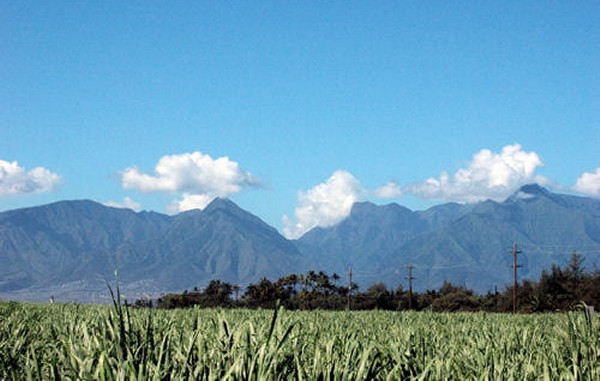
That
is not Haleakala in the background of the sugar cane crops,
but rather a rugged complex of mountains just west of
Kahului known as the "West Maui Mountains".
Although these mountains pale in comparison to the gigantic
Haleakala, they are actually pretty impressive in their own
right. If you have ever heard of the
Iao Needle, you
can find this unusual formation in the center of those
mountains.
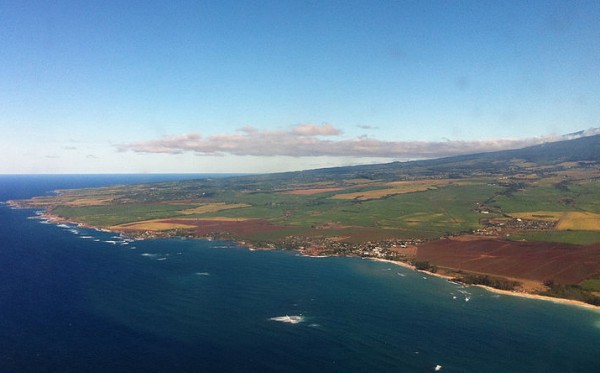
Pa'ia
is said to be start of the Road to Hana. If you are
low on gas, get it here. The next gas station is in
Hana 50 miles to the east.
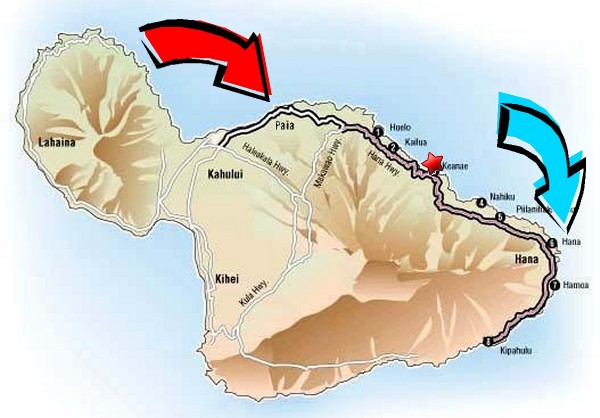
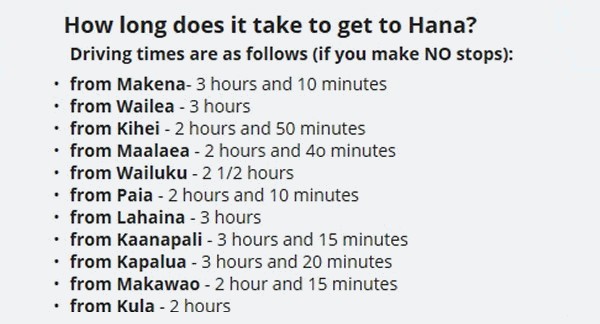
I am
sure you have heard the pace of the traffic on the Road to
Hana can be maddening slow at times. If Pa'ia is 50
miles from Hana and takes over two hours, that works out to
about 20 miles per hour.
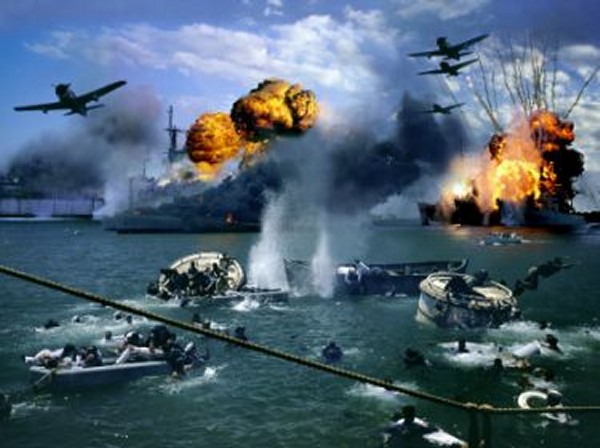
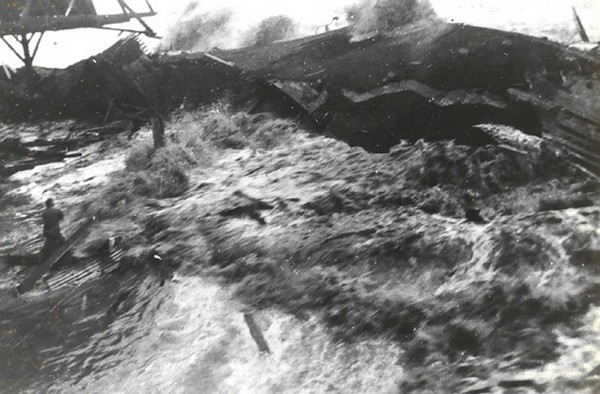
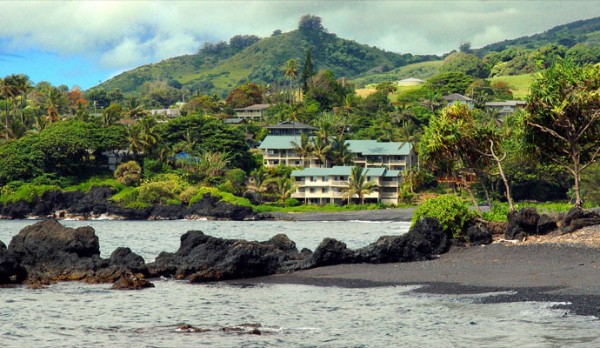
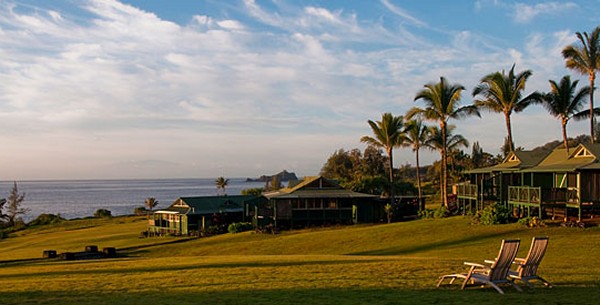
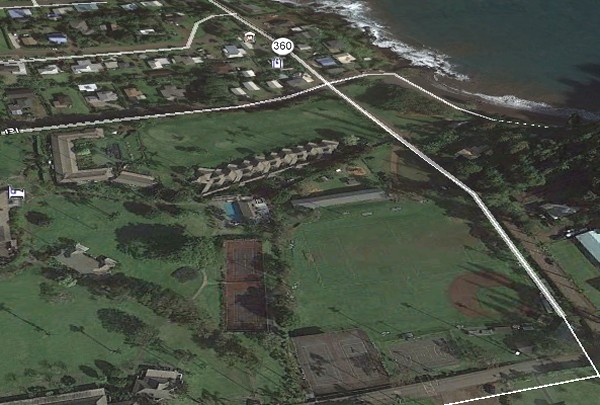
Here
is Hana's current baseball field. It is located 300 yards
from the ocean in the same spot where the "Seals" once
trained. That "360" stands for Highway 360, better known as
"The Road to Hana".
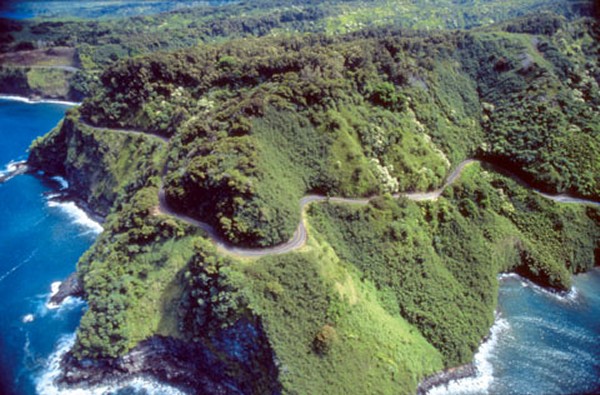
Another picture of the
Road that has made Hana famous. You really do not want
to drive aggressively on this road. These curves make
it impossible to see some oncoming vehicle from the other
direction.
|
| |
|
Confusion on Maui
•
No one can decide where
the Road to Hana begins.
From what I gather, both Kahului and Pa'ia
argue over which is the "true" start point for the Road
to Hana. The Wikipedia listing for "Hana Highway" cites
Kahului as the start point.
It took the President
of the United States to finally solve the problem. In
2000, President Bill Clinton renamed the Hana Highway.
Calling it the “Hana Millennium
Legacy Trail”, the official trail starting point was now
listed as
Pa'ia. I am sure you find the debate fascinating.
•
No one seems to know to
measure distance.
Many of the tour guides use
Kahului as their
measuring point for the Road to Hana. Some
books say the Road to Hana is 68 miles long.
Other books say Hana is 52 miles from Kahului.
One person said she was positive the distance is 48 miles.
I think the discrepancies
have something to do with
measuring the end point. Some people measure to
Hana. Other people measure to Kipahulu or Lindbergh's Grave,
both of which are located well past Hana.
Personally, when I measured the distance between
Kahului and Kipahulu using
Google Earth, I got 50
miles, not 68.
So is the distance from Kahului to Kipahulu 68
miles long or is it 50 miles long? Maybe the experts
measure the distance based on all those 600 S-curves.
Sort of like our intestines... you know, the small intestine
is 20 feet long and the large intestine is 5 feet long and
they both fit in a space half a foot long.
•
And that brings up
another question.
Why is the small
intestine longer than the large intestine?
I don't get it.
You know, I could go crazy figuring all this stuff out.
•
Another thing I don't
understand are the markers on the side of the road.
I found the signs along the road to be either utterly
useless or non-existent. Considering how much wealth
the "Road to Hana" brings
to this area, one would assume they would make this road as
user-friendly as possible, but I think not.
Here is a blurb I found about the mile markers:
Did you know that the mile markers on the Road to Hana start
over about 9.5 miles outside of Paia? That is where
Highway 36
officially ends, and county road 360 begins. When county road
360 begins, the mile markers start over at zero.
Since mile
markers are the best way to navigate the Road to Hana, be
sure to pay attention to the transition – it takes place
near the Millennium Legacy Trail Monument.
Considering all the guide books use the mile markers to
indicate the location of various places, I found it very
strange that I could not find a single map on the Internet
that actually showed the mile markers in relationship to the
Road to Hana.
•
I was curious to
know how many people drive this road every day.
I should not have
asked that question because I was very unhappy with the only
answer I could find.
I
found a
City of Hana "statistics" page that suggested the
average daily traffic was nearly 47,000 a day.
Hmm. Now, is that 47,000 cars or 47,000 people?
Considering they were discussing "bridges" at the time, it
very well could be 47,000 vehicles crossing certain bridges
per day. Let's hope not. I have a
hard time believing
2,000 vehicles an hour
cross those
one-way
bridges
24 hours a
day.
If you are counting, that's 33 bridge crossings per
minute.
And if it is 'people' they are counting, how do they get an
accurate head count? Do they weigh the cars as they
cross the bridge? "Now this car weighs like it has 4
people in it."
Whatever they are measuring, I find this "46,955" statistic
to be preposterously high. Maybe someone
can explain.
•
They say 2.2 million
people visit Maui annually. (source:
Go Hawaii). That seems like a huge number, but
when you do the math, 2.2 million averages out to about
6,000 people a day.
Now that number seems low. For example,
our cruise ship alone dropped 3,000 people into Lahaina two
days in a row.
My conclusion is that the entire island is confused. No one
can decide where the Road to Hana begins or ends. They
can't measure distance worth a flip. None of their
statistics make any sense and their road signs are utterly
useless.
Thanks to "Old Machete Marko", I think I know what the
problem is. I suggest there is too much medical
marijuana being grown in the jungle. No wonder they can't
find that birth certificate.
|
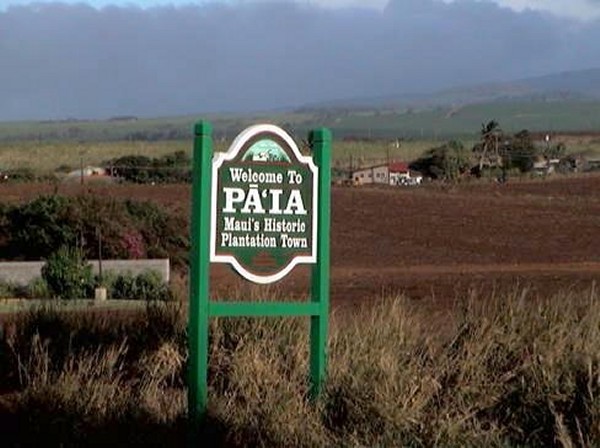
Both Kahului and Paia argue over which is the
"true" start point for the Road to Hana.
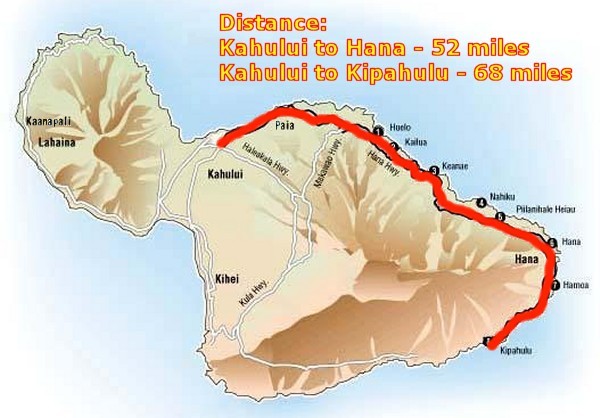
Everyone seems to agree that the Road to Hana doesn't end in
Hana, but rather in Kipahulu. So why doesn't someone
simply rename it
"The Road to Keep-a-Hula Hoop"? That seems so much
catchier.

Rick's
Note: If you don't believe those numbers exist, go
look for yourself!
City of Hana,
Go Hawaii
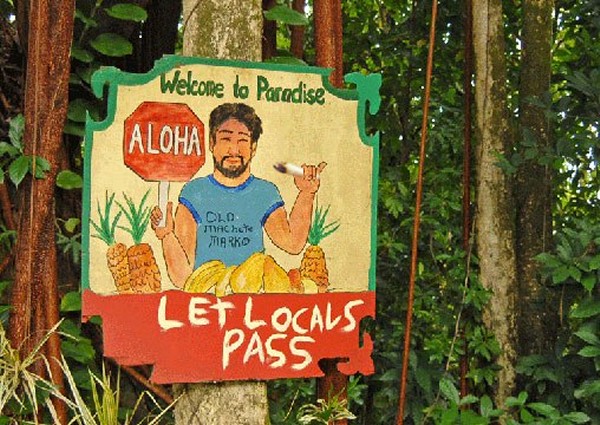
Rick's
Note: If you read my stories about
Nahiku and the
Blue Pool Waterfall,
then you are well aware the locals can be very hostile at
time towards the massive influx of tourists.
|
| |
Driving
the Road to Hana
|
Twin Falls
Well, the time has come to see what all the fuss is about.
About ten miles down the road from Pa'ia, we came across our
first place to visit. It is a waterfall known as
Twin Falls.
You cannot see Twin Falls from the road, but this rickety
little shack gives the average tourist such as myself an odd
indication of its presence.
Here is a good
review:
Twin Falls
is the first waterfall on the Road to Hana. Several
trails lead to these falls (which actually number more
than two). These falls are not as spectacular as some of
the other falls along the Road to Hana but, if you have
the time and it is not raining, they are worth the stop.
The first and closest set of Twin Falls has a rope swing
that drops into a natural pool below the fall. The
second Twin Falls is about another mile up Ho'olawanui
Stream. Daredevils frequently jump from the top of these
falls into the pool below. Recent rains can make the
stream and waterfalls unpredictable and unsafe. Check on
weather conditions before attempting these hikes.
Here is a less good review from
Guide of Hawaii.
Twin Falls
(Mile Marker 2) - By far the largest waste of time when
starting the drive. We see cars by the dozen piled up
here and we just can't put two and two together.
Compared to what's ahead of you, it's a waste of time.
We only note it here because so many people DO stop
here. The vendors are very friendly and offer some good
products, but other than that… just skip this stop.
And here is what the Twins Falls looks like.
Unfortunately, the second review was accurate. It took
us forever to find a parking spot, it was long walk, it was
hard to get to, and very crowded.
We should have kept driving.
|
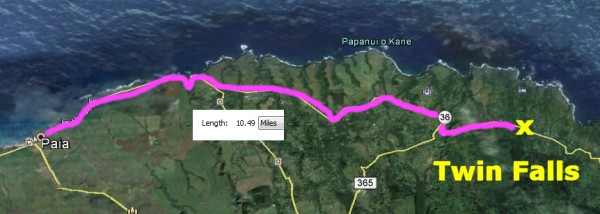
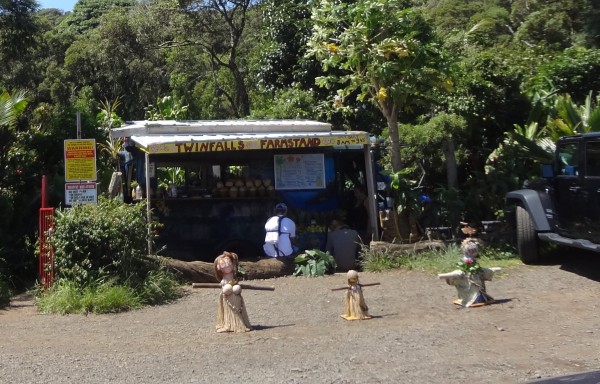
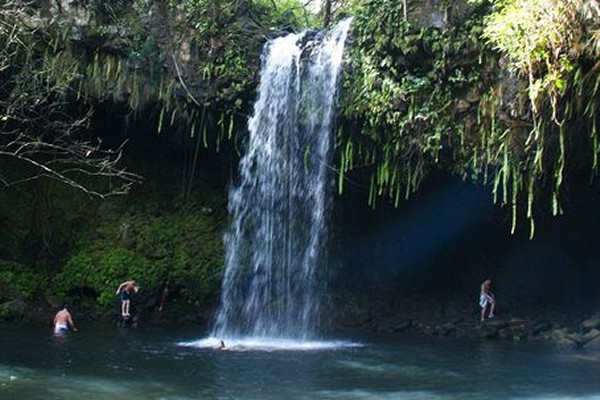 |
| |
|
Garden of Eden
Arboretum
The Garden of Eden Arboretum is said to be about the halfway
point on the way to Hana.
Marla and I drove up to the gate, but decided not to go in.
As always in these situations, we didn't know how much time
would be involved.
As it turned out, maybe we should have gone in.
Here is what
Guide of Hawaii had to say:
Garden of
Eden (MM 10) - One of the best Gardens on Maui, we
consider this a must see. The admission price is a bit
steep at $15/person, but the Garden is meticulously
maintained and worth a visit.
It offers
several great panoramic overlooks of the Pacific and
also offers you a view of both Lower and Upper
Puohokamoa Falls.
On the way
out you have the option of stopping in a gallery where
you can find beautiful products made by local artists.
Right before you exit the grounds there is little spot
where they serve home made ice cream, definitely a treat
if you are in the mood.
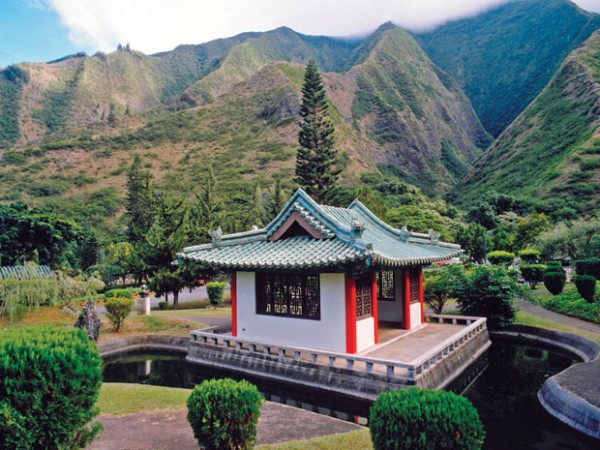 |
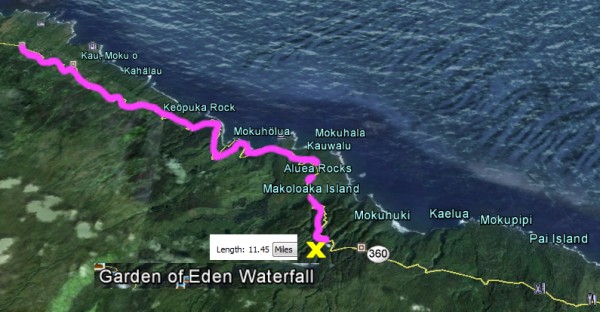
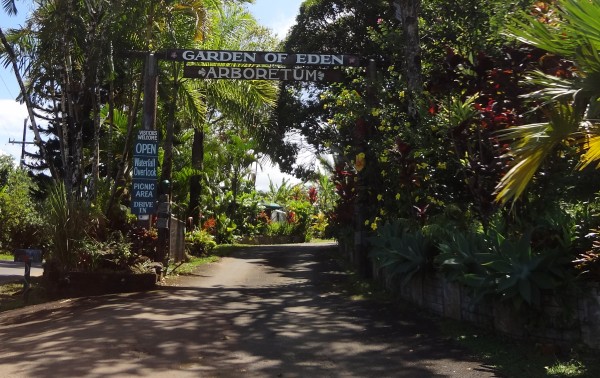
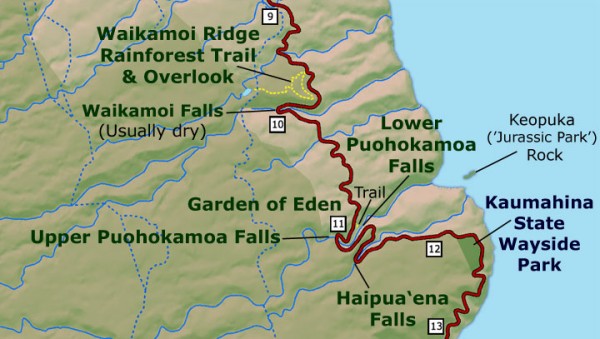 |
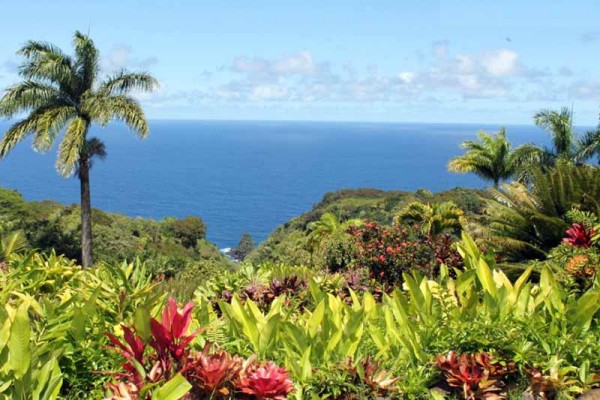 |
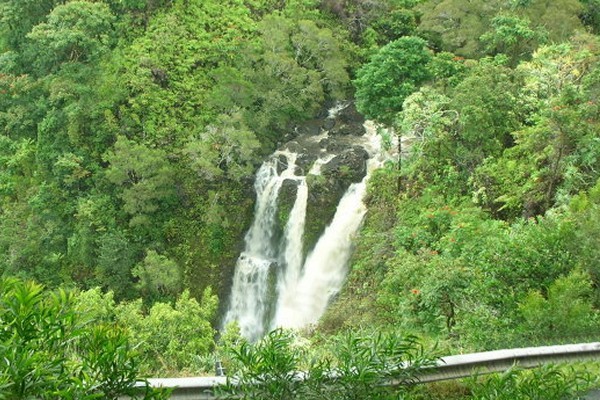 |
| |
|
The Crazy
One-Way Bridges
They say there are 52 bridges on the Road to Hana. The
vast majority of these bridge are one-way.
In the picture on the right, I am "yielding"
In the picture below, it's my turn to cross the bridge.
The third picture indicates just how narrow these bridges
are.
Once in a while, we arrived at the bridge at the same time
as the car on the other side. I estimate this happened
at one bridge in five. Since we were not in a hurry, I
probably "yielded" more than my fair share.
Manners are quite important on the Road to Hana.
|
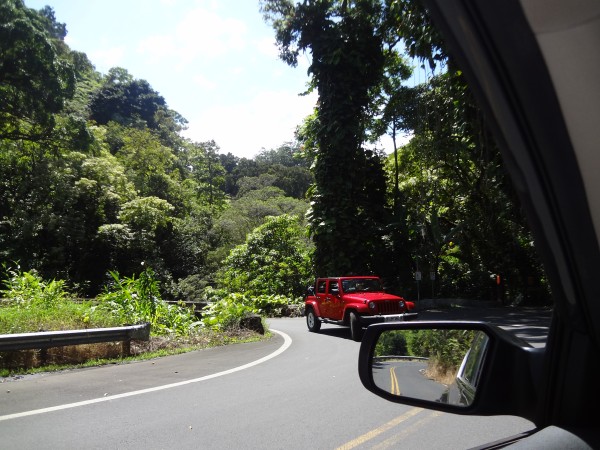 |
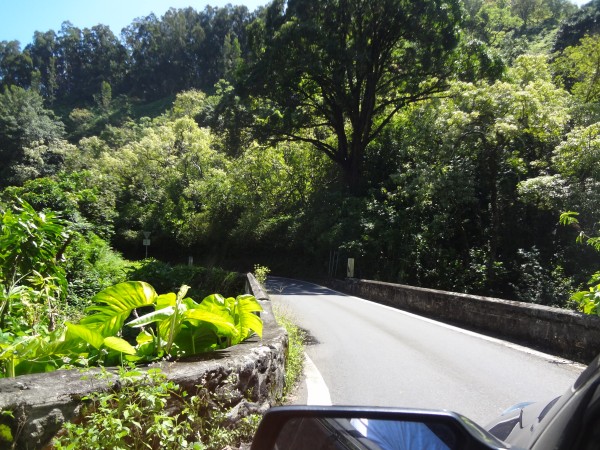 |
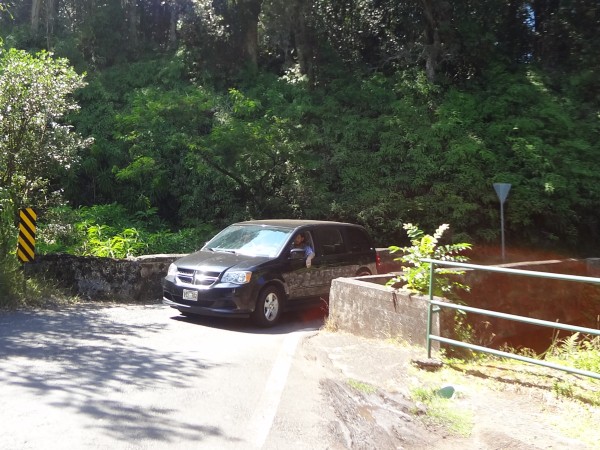 |
| |
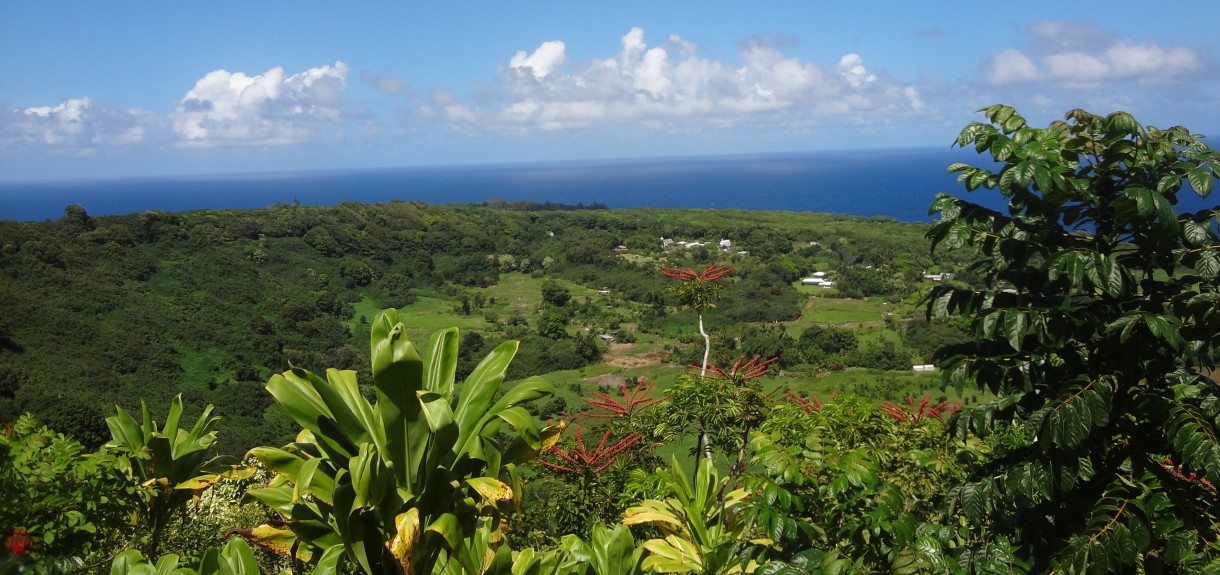 |
Panoramas
There are breath-taking vistas that present themselves at
practically every turn of the road. Wherever you look,
there is beauty as far as the eye can see.
It is sights like these that have made the Road to Hana so
popular.
One of the things I have noticed is you have to see it to
appreciate it. As I review my pictures from the trip,
they don't have nearly the impact that I felt when I took
them.
The pictures do a good job of making me smile, but it is
so much better to see these stunning panoramas in person.
I
would take The Road to Hana again in a heartbeat.
|
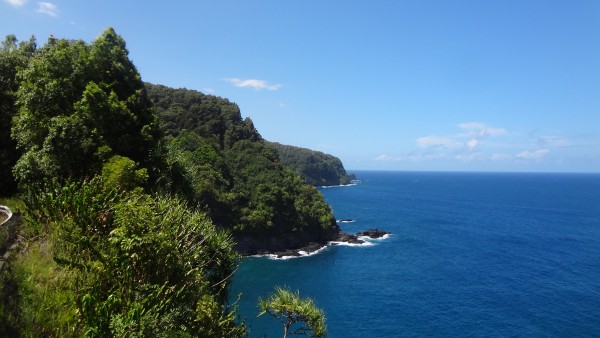 |
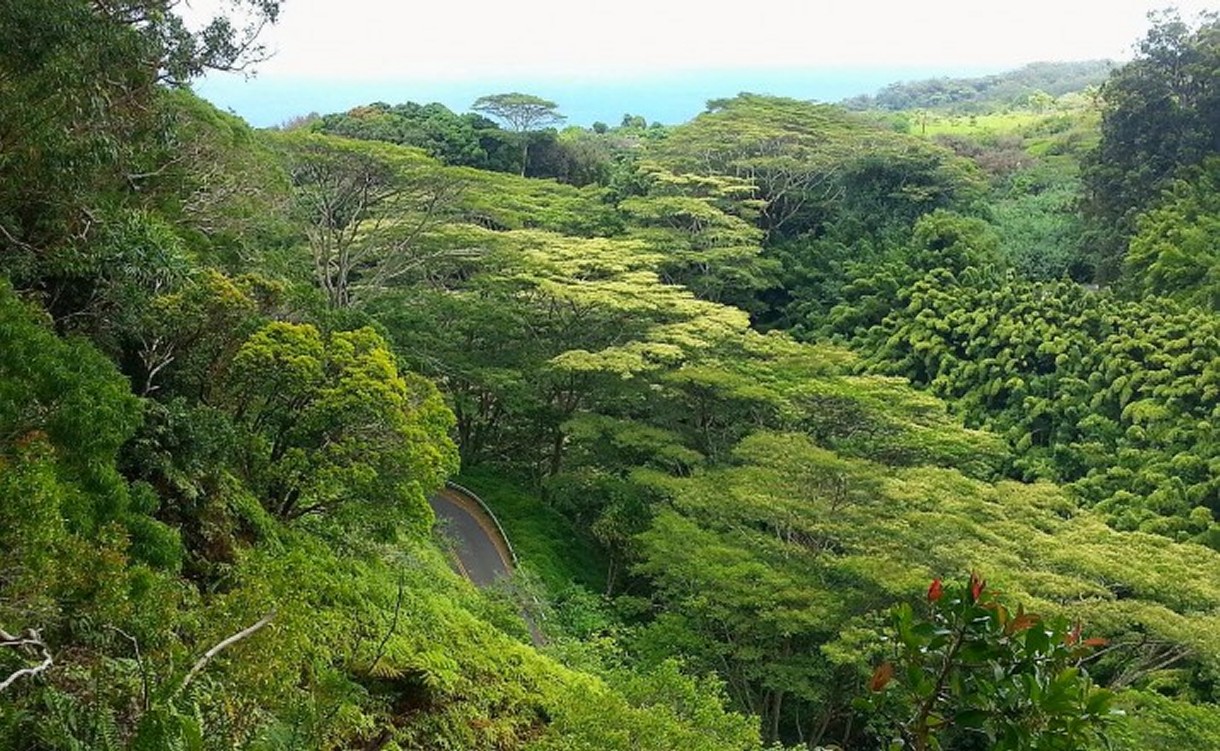 |
| |
|
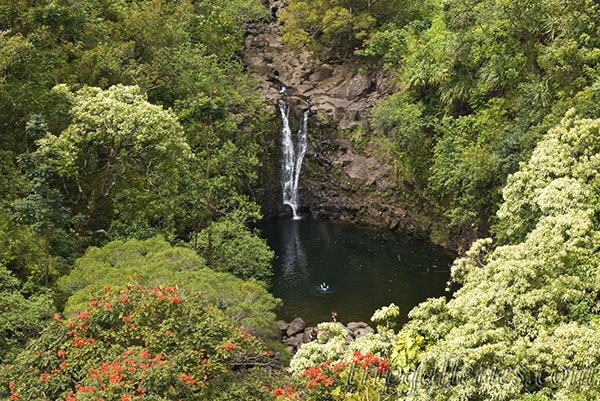
Lower and
Upper Puohokamoa Falls
|
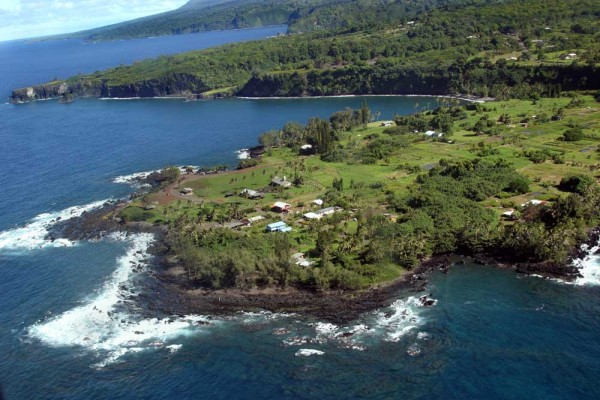
Keanae
Peninsula
|
A Quick
Overview
The people at
Hawaii Guide did a far better job of describing the
next set of highlights than I can ever hope to, so I will
simply share their excellent comments with our readers.
What I like about Hawaii Guide is they are more than
willing to speak up and say "no big deal". I
appreciate anyone who prefers to avoid the hype and pretend
everything is paradise. These guys call it like it is.
Lower and
Upper Puohokamoa Falls (MM 11-12) - The lower falls is
before the upper falls, and is posted with "Posted"
no-trespassing signs. If you can get permission to stop like
we did, it's a worth-while stop. This doesn't exactly stop
the masses, as the fence has a giant hole in it and there's
an extremely well worn path to a very pretty overlook of the
falls (don't proceed any further than this).
We don't
condone exploring areas that are posted, so whether you
visit this spot or not is at your discretion. We did so with
permission and thought the initial falls overlook was
pretty; but nothing special. Upper Puohokamoa Falls is
blocked access wise. If you want to see either of these
falls legally, there's a much easier way. Stop in the Garden
of Eden for a view of both falls from two respective
lookouts within the garden.
Kaumahina State Wayside Park (MM 12) - A pretty park
that was 'upgraded' facilities wise a few years ago. Offers
nice views of Keanae Peninsula ahead of you, but
beyond that, nothing worth stopping for; so you could easily
skip this spot and never miss anything in our opinion.
Honomanu Bay Lookout (MM 14) - One of the best stops
along the Hana Highway that allows you to actually SEE the
Hana Highway as it snakes across the cliff side. Our
favorite pull out is the very large one (on the mauka/inland
side of the road) 4/10th of a mile past MM 14. The other
pull outs are either obstructed by vegetation or do not
offer the same quality view as the aforementioned pullout.
Keanae Peninsula and Village (MM 17) - Worth a stop
if you have some extra time. The coastal views are
beautiful, and it's a neat way to see one of Haleakala's
most recent lava flows up close (you're on it).
Upper Waikani (Three Bears) Falls (MM 21) - This is
one of the best falls on the Hana Highway when the weather
is cooperating. A lot of rain can make the falls a rushing
torrent of water, which is not as pretty as when it has a
lighter flow.
Access to the falls, which you make at your
own risk, is easiest from the makai (ocean side) of the
bridge on the end towards Hana town. Cross under the bridge
and proceed over to the falls using extreme caution. You'll
be surprised just how BIG the falls are when you're standing
before them.
Puaa Kaa State Wayside Park (MM 22) - In our opinion,
it's a spot you can skip. We note it because everyone stops
here for either the facilities or lunch. None of the
waterfalls are worth stopping for, so keep on moving.
After Puaa Kaa State Wayside park there are a number of
stops we detail online and in our book – but most, if not
all, can be skipped. Many of the waterfalls are small and
not worth your time in our opinion.
|
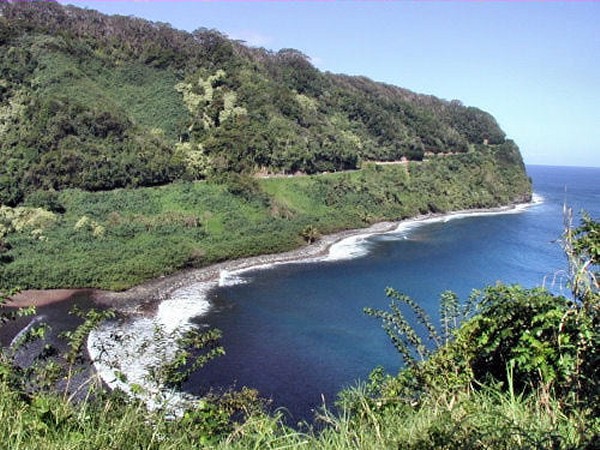
Honomanu
Bay Lookout
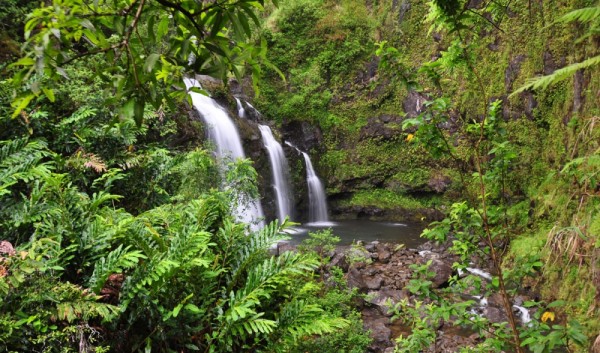
Upper
Waikani (Three Bears) Falls
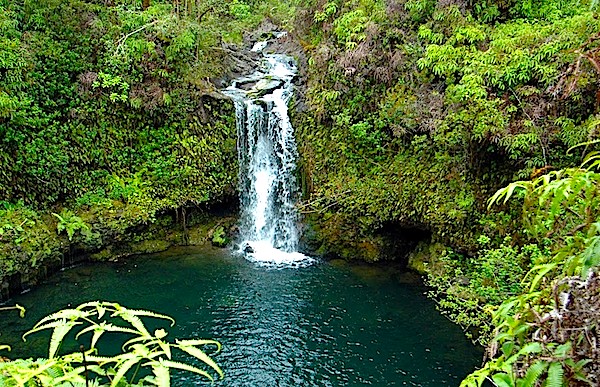
Puaa Kaa
State Wayside Park
|
the thing that i would miss the most on that drive, if it
was raining buckets...would be buying the organic fruits, fruit
breads (banana, mango ect) that are set up by the side of the
road...we eat our way down that road each time!!
|
|
|
Waianapanapa State Wayside Park (MM 32) - One of the
only black sand beaches on the island of Maui is at this
spot. Also makes a great spot for lunch. You can probably
skip the wet caves portion, we've never been overly
impressed by that part of the park. Not to mention some
folks seem to have used the caves as a restroom – so that's
another good reason to skip them.
Hana Town - Honestly, no joke, nothing to see in Hana
town besides a few little stores with souvenirs . Keep
heading towards the Oheo Gulch if you've got time left, or
turn back to see some of the smaller sights.
|
|
The South Road
A little over 2 miles south of Kipahulu the road starts to
deteriorate. For about 10 minutes it becomes a sketchy single
lane road that's drivable but a little scary because it's narrow
and beside some cliffs for part of the way. Fortunately there
isn't much traffic. After that there's an intermittent dirt road
that lasts for 15 minutes. Then comes a paved road that's been
repaired an inconceivable number of times making it terribly
bumpy. That section is a little over 8 miles in length but
you'll be driving it so slowly it will take almost an hour. The
remainder of the highway is smoothly paved. The highway goes up
to Kula on the slopes of Haleakala, and then back down to
Kahului.
The driving time is about the same whether you turn back at
Kipahulu or continue on. The scenery on the backside of
Haleakala is very different than what you would have seen up to
this point. It's dry and unpopulated, but still beautiful with
vast vistas of open space. The sun will be setting as you drive
along the highway heading west now, which could also add some
magic (you don't want to do this drive at night). However, the
road's bumpiness is very unpleasant. Also, should your car break
down here for some reason, the cost to get it towed will be
astronomical. |
|
Maui gave ex-Beatle Harrison the quiet he craved
By Timothy Hurley
Advertiser Maui County Bureau
WAILUKU, Maui — The Quiet Beatle lived up to his nickname on
Maui in a big way, rarely leaving his estate, keeping a low
profile and never performing in public, as far as anyone can
recall, during the 20 years he counted himself as a part-time
resident.
George Harrison, 58, who died of cancer Thursday in Los Angeles,
escaped suffocating celebrity by coming to Maui and embracing
the local community in Nahiku.
"He gravitated toward the people of the earth. He had a fondness
for them,'' said Michael Spalding, who represented Harrison in
his real estate and financial dealings when he first purchased
his 63-acre East Maui property in 1981. He would later buy more
than 100 additional acres there.
"When he came to Maui, he didn't seek out the mighty, the rich
and the powerful. He sought out the Hawaiians. He was very loyal
to the people he befriended, and they were very loyal to him,''
Spalding said.
Nahiku residents, such as Arnold Allencastre, knew Harrison
simply as Keoki.
"He was a good guy, a nice guy,'' said Allencastre, whose father
once owned the land Harrison had acquired. "He liked the local
people, too.''
Harrison hired Allencastre, a heavy-equipment operator, to help
clear his land so he could build his house and plant his
gardens. But their relationship wasn't just a working one.
Allencastre and his wife, Cynthia, would socialize with the
Harrisons. George and his wife, Olivia, would come to their
parties and they, in turn, would be invited to an occasional
lunch.
The last time Allencastre saw Harrison was about a year ago when
he and Olivia stopped by to say hello and catch up on what was
happening in town.
Former caretaker Dot Pua remembers
Harrison as a sweet and thoughtful boss. One time, when she was
cutting his hair, Harrison asked about her favorite songs. Her
reply was, " 'While My Guitar Gently Weeps' by Kenny Rankin,"
and a couple other tunes. Harrison didn't say anything.
It was only years later, while leafing through a Beatles
songbook, that she discovered that "While My Guitar Gently
Weeps'' was written by Harrison.
"My goodness, he must have thought I was so dumb,'' she said.
Pua, now a beautician at the Hotel-Hana Maui, said her time at
the Harrison estate was a wonderful experience.
"But it made me appreciate my simple life,'' she said. "When I
was hired, Olivia told me my life will change — and it did. We
got a dog and locked the doors, something we never did before.
Strangers kept coming onto the property.''
Strangers were something Harrison worked hard to avoid and that
aversion exploded into a lawsuit with neighbors who were
allowing visitors to use a path over his property to get to the
ocean. The lawsuit was finally settled this year.
"He used to tell me that he wanted to be famous, but after three
or four months it was the worst thing that happened to him,''
said restaurateur Bob Longhi, who was introduced to the former
Beatle in 1977 and continued as a friend.
"George was a super guy, a humble-type person. He wasn't like,
'I'm George Harrison.' He was fun-loving.''
Harrison fell in love with Maui, Longhi said, and in 1979 wrote
"Soft-Hearted Hana,'' dedicating it to Longhi on his "George
Harrison'' album.
Paul Weinstein, owner of Bounty Music in Kahului, remembers the
former Beatle coming into his shop anywhere from six to a dozen
times over the years.
He said Harrison was fascinated with the 'ukulele and bought
perhaps as many as a dozen over the years.
During one visit, Weinstein allowed him to try out various
instruments in an office behind the Hana Highway store.
"It was one of the thrills of my life,'' he said. "Whoever
thought I'd be able to sit in a room, just me and him, and be
able to hear him try out some instruments.''
Maui guitarist Harry Troupe, a former Bounty Music manager, said
he was stunned to find Harrison in the shop one day.
"He was so humble to me,'' he said. "It really floored me to see
a guy of that stature treat me the way he did. You could just
feel the warmth from him.''
http://www.beatlesbible.com/forum/george-harrison/george-on-maui/
|
|
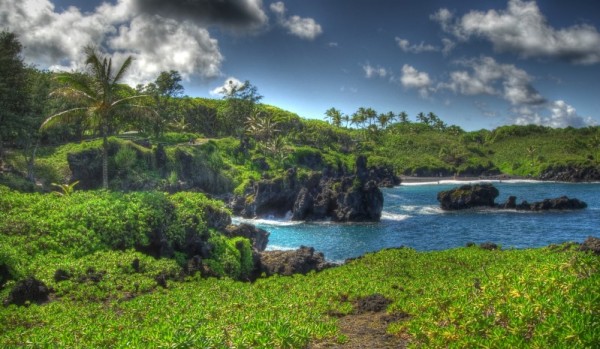 |
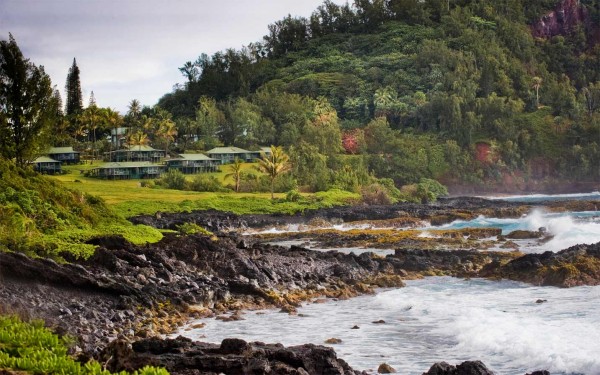 |
Danger! Falling Rocks: A Journey Back from Hana
They told us not to do it.
They told us and they told us and they told us, "Whatever you
do, do not take the back road from Hana."
If you've been to Maui, you know that the first thing people
tell you is, "You have to take the road to Hana. You have to."
They tell you this with a knowing look; then proceed to warn you
solemnly that the curvy, narrow road to the far side of the
island will likely make you violently carsick. "But it's totally
worth it," they add cheerfully.
However, the same people who tell you that you have to take the
road to Hana are vehement that you not take the other road, the
"back side" as it's often described. Highway 31.
I had escaped to Maui for four glorious days with my friends
Arianne and COL-e -- a girls' trip, though as moms to youngish
children, this was the first in years. We had each been going
through some personal challenges, and had come on vacation to
relax and unwind -- but mostly to laugh.
But back to the road.
Even the car rental folks told us not to take the back road --
in fact, they made us sign a piece of paper to that effect. The
leather-skinned agent had given me a map of the island when I
asked about Hana. "Hey, look, you guys," I said, pointing to a
squiggly line on the map. "It's seems much shorter to come back
from Hana this back way. We could just do a loop."
The agent's ears perked up. "Absolutely not," she said. "It's
against policy to take the rental car over there. It's not even
paved. No one drives on that road."
Now she had my attention. The road less traveled? Sign me up.
No, sign here. She shoved the agreement towards COL-e, none too
pleased that we were passing on her generous offer to upgrade to
a Hummer for an additional $100 a day. Nah, we're fine with our
Nissan Vibe, thank you very much.
I could go on about the sunrise from Haleakala, the Ali'i Kula
Lavender Farm, the Cucumber Green Tea Martinis at the Four
Seasons Maui, the Standup Paddleboarding with our new friend
Blaze at Maui Undersea Adventures, and our spectacular
sailing-snorkeling trip on the Ali'i Nui Catamaran, but let's
get right to it. You know where this story is headed.
I'll save the details of the road to Hana for another time --
and yes, the winding road through lush rainforest with panoramic
views was worth it. In fact, the Road To Hana is a breeze if
you've ever driven the PCH to Big Sur. We took our time, popping
by the Hotel Hana-Maui for a quick hit of island elegance
infused with magic. By the time we made it to Oheo Gulch (the
Seven Sacred Pools, as the tourists call it), it was dusk.
"You can only go as far the first waterfall," the ranger
quipped. We hadn't realized that the sun was about to set. We
quickly hiked the ankle-breaking path to the first waterfall,
wondering aloud how long it would take us to get back to the
other side of the island. Overhearing us, a couple hiking near
us informed us that the back road was much faster -- and that
the locals always take it. "It's totally paved now," they
assured us. That's all we needed. So as the sun sank into the
ocean, we headed down the backside of Hana, defying our rental
car agreement and all the naysayers.
For the first few minutes, we were mesmerized by the exotic
terrain and otherworldly views. Then, suddenly, we found
ourselves on a narrow dirt and lava rock road, literally hugging
a cliff along a sheer drop -- with no guardrails. We went silent
with the knowledge that heading down this road in the dark was
probably not a good idea. The bad news was that there was no
place to turn around.
Every hairpin curve was blind, but it didn't matter, because I'm
not sure how an oncoming car could have passed us anyway. Signs
reading "Danger, Falling Rocks" reminded us that there were
boulders just inches away, waiting to crush us, and crosses
memorializing those who had plummeted to their deaths dotted the
highway. "And those are just the ones that are marked," muttered
Arianne from the back seat.
Nerves rattled, I squeaked out the obvious, "This isn't paved."
Arianne and I closed our eyes, shutting out the view down the
mountainside, and at some point, I had tearful catharsis about
how this road was like our lives... "We have no idea what's
ahead of us, but we can't turn back." I was melting down. COL-e,
on the other hand, was cool as a cucumber; she was driving,
after all, and at least had the illusion of control.
Finally, after another hour of dark and desolate road, where the
only living beings we encountered were cows (in the middle of
the road, mind you) -- and where just one small patch of the
road was actually paved -- we found our way back to
civilization. More importantly, we found our way to Bev Gannon's
Hali'imaile General Store, a restaurant in the middle of nowhere
we had heard about.
Thrilled to be alive, I savored every bite. Butternut squash
soup with coconut milk and ginger... Roasted beet, Marcona
almond and goat cheese salad... Macadamia nut crusted
mahi-mahi... And plenty of wine... I think it was a Sancerre,
but who cares? Forget the amuse buche - there's nothing like
fear to awaken the taste buds. As I polished off the caramelized
pineapple upside-down cake, I told our server about our
adventure. She looked at us blankly - "My husband drives that
road twice a day," she said, shutting us down. Fine, lady, but
in the dark?
All through dinner -- and the way home -- we talked about that
road. We especially relish mocking the couple from the trail.
"It's totally paved," we intone, before breaking into laughter
again. And again. Which was just what the doctor ordered.
http://www.huffingtonpost.com/jennifer-evans-gardner/danger-falling-rocks-a-jo_b_795147.html
|
|
|
Touring the Road to Hana INDEPENDENTLY
Advantages
- It’s less expensive. If you’ve rented a car, the only added
expense is the cost of the gas for the day. A family of four
could save around $400 on a self guided tour.
- You have the freedom to stop where you want.
- You are sharing your experience with your traveling partner(s)
only.
- You have a greater sense of adventure.
Disadvantages
- Finding landmarks on an extremely curvy road in a rainforest
is a challenge. It’s very easy to miss stops, waterfalls and
short hikes that you were hoping to find.
- Driving this road is challenging. There’s hundreds of curves
plus dozens of one-lane bridges. It takes quite a bit of
concentration for the driver and can be stressful. The driver
doesn’t get to enjoy the scenery since he/she is focused on
driving.
- Your rental vehicle could become a target of either theft or
hostile behavior. (See my advice that you should NEVER leave
valuables in your rental car.)
- You need to be careful about how you use your time in order to
avoid driving home in the dark.
- If you are driving in a car, your view may be limited at times
because of the height of hedges.
- Rental car agencies don’t contractually permit you to drive
the full loop around the “back side” of the road to Hana.
_____________________________________________
Touring the Road to Hana on a GUIDED TOUR
Advantages
- Guided tours take all the stress out of driving this road.
- Everyone in your party gets to take in the scenery.
- Tour guides share many interesting history, stories, and
legends about the sights along the road.
- Tour guides know the road very well. They won’t miss sharing
the highlights with you.
- Your tour guide will most likely keep watch of any valuables
you leave on the tour van.
- You’re less likely to be hassled by hostile local behavior.
- You don’t have to worry about how you are budgeting your time
in order to avoid driving back in the dark.
- Some of the guided tours will take you around the “back side”
of the road to Hana. (That road is not approved by the major
rental car companies.)
- The view out of the van windows is a bit elevated, which
allows you to see views over hedges.
Disadvantages
- Guided tours are much more expensive than driving
independently. Budget at least $100 or more per person for a
guided tour.
- You share your experience with a group of strangers –
typically around 10 – 12 folks.
- You can’t stop whenever you want.
__
I think next time, I’ll take an organized tour just for
comparison. How about you? What’s your preference? What
additional advantages or disadvantages do you have?
—-
2011 Update: I did indeed take a guided tour of the Road to Hana
with No Ka Oi Adventures. It was an excellent tour geared
towards the person who likes hiking, secluded waterfalls and no
crowds!
Originally posted at: Touring the Road to Hana Independently vs.
Guided Tour | Go Visit Hawaii
http://www.govisithawaii.com/2010/04/14/touring-the-road-to-hana-independently-vs-guided-tour/ |
|
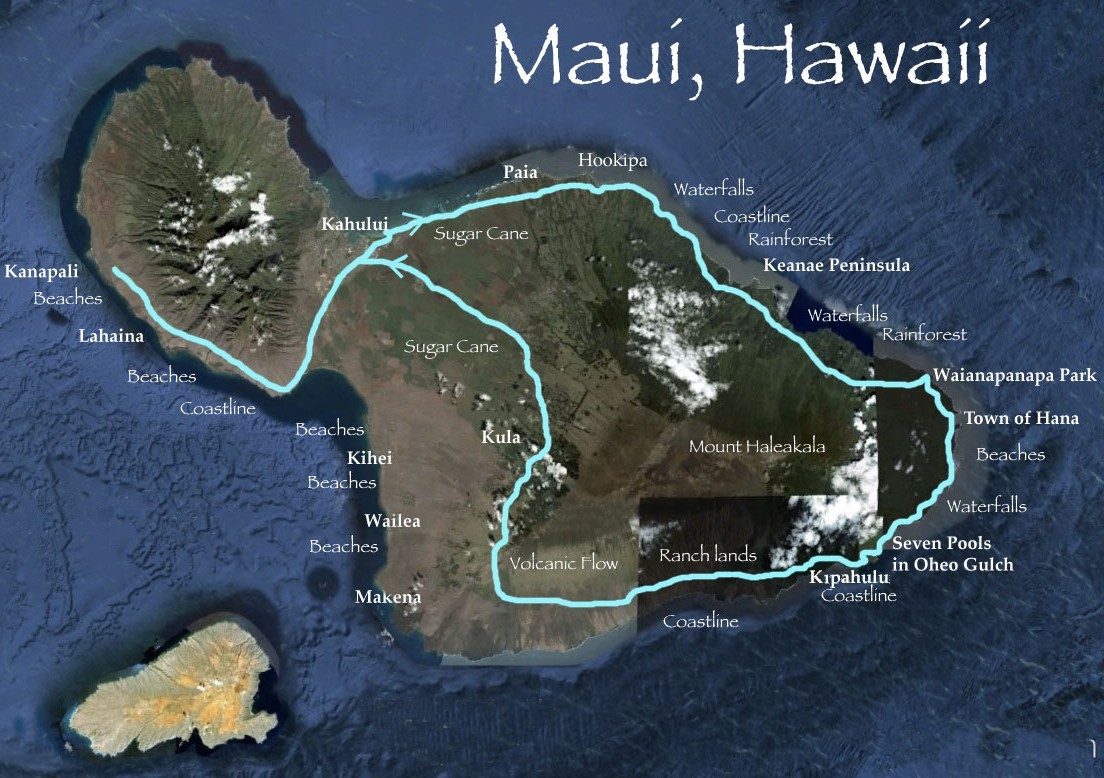 |
The South Road
A little over 2 miles south of Kipahulu the road starts to
deteriorate. For about 10 minutes it becomes a sketchy single
lane road that's drivable but a little scary because it's narrow
and beside some cliffs for part of the way. Fortunately there
isn't much traffic. After that there's an intermittent dirt road
that lasts for 15 minutes. Then comes a paved road that's been
repaired an inconceivable number of times making it terribly
bumpy. That section is a little over 8 miles in length but
you'll be driving it so slowly it will take almost an hour. The
remainder of the highway is smoothly paved. The highway goes up
to Kula on the slopes of Haleakala, and then back down to
Kahului.
The driving time is about the same whether you turn back at
Kipahulu or continue on. The scenery on the backside of
Haleakala is very different than what you would have seen up to
this point. It's dry and unpopulated, but still beautiful with
vast vistas of open space. The sun will be setting as you drive
along the highway heading west now, which could also add some
magic (you don't want to do this drive at night). However, the
road's bumpiness is very unpleasant. Also, should your car break
down here for some reason, the cost to get it towed will be
astronomical. |
|
|
|